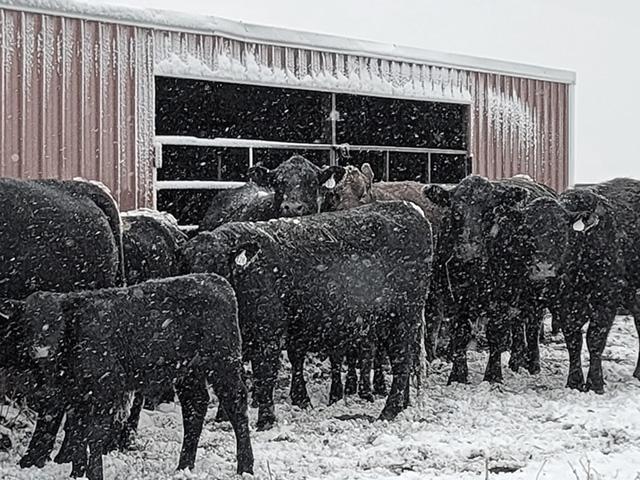Protect Livestock From Polar Vortex
Livestock Face Risks in Extreme Weather, From Heavy Snow to Polar Vortex Impact Later This Week
OMAHA (DTN) -- A huge winter storm is moving across the United States early this week for both the central and eastern part of the country. On Monday, some areas already had blizzard warnings with heavy snow and very strong winds. Another winter storm is expected later in the week, followed by a polar vortex to cross the middle of the U.S. later in the week and plunge temperatures well below normal.
Livestock producers need to have a plan to protect their animals from these challenging snowy, windy conditions and be ready for when extreme cold hits, according to Extension specialists.
Colorado State University (CSU) Extension has an extensive list of severe cold weather considerations (https://extension.colostate.edu/…).
MOVE CATTLE
The CSU report suggested moving livestock before or at the onset of extreme winter weather. For short durations, landscape topographic features such as ravines, canyons, draws and natural windbreaks may be sufficient protection from the elements.
Cold weather without wind is usually not enough to affect the performance of animals. But wind alone can cause the same effect on animals as exposure to a sudden drop in temperature. A 20-mile-per-hour (mph) wind is roughly equivalent to a 30-degree Fahrenheit drop in temperature.
This week's storms will bring high winds with them.
HIGH WINDS EXPECTED IN PLACES
DTN Meteorologist John Baranick said the storm will move across the Plains before arcing back up into the Northeast by the middle of the week (https://www.dtnpf.com/…). For the West and Central United States, it will be a very potent ball of energy, he said. The low will shift eastward into Missouri on Jan. 9, then northeast toward Toronto for Jan. 10.
"Models have actually had a very consistent track with this storm in this general path, a sign of consistency and confidence in how this storm will track," Baranick said. "Timing with this storm has also been consistent during those days."
With these storms, usually, the northern side of the track will see heavier snowfall. That is bringing Colorado, Kansas and Nebraska northeast through Wisconsin and Michigan with the likelihood of 6 to 12 inches of snow. Widespread precipitation is expected from Texas to Nebraska.
P[L1] D[0x0] M[300x250] OOP[F] ADUNIT[] T[]
In addition to the snow, the powerful storm could also produce strong winds. Widespread wind gusts of 50 to 60 mph are being felt in the southwestern Plains. Winds may not be that high in the Midwest, more in the order of 35 to 45 mph at times. Winds may be strong enough to produce whiteout conditions for a time, Baranick said.
HOW TO PROTECT CATTLE FROM WIND, COLD
To protect their livestock from the wind and cold, producers should utilize shelter, sheds or windbreaks.
Windbreaks that are taller and denser (have fewer openings) are more effective than other types of windbreaks. Windbreaks can be manmade or natural, generally trees.
See tips on how different windbreak designs can help protect livestock, as well as lower feed costs, here: https://www.dtnpf.com/….
Having a winter management plan can help livestock survive the extreme weather: This includes being prepared with extra feed.
Cattle in low temperatures should have abundant and accessible feed; cattle need extra feed to maintain their body temperature and body condition.
DTN's weather forecast shows just how much temperatures and wind chill are about to change.
POLAR VORTEX LATER THIS WEEK
Baranick said this week's snowstorms will precede a visit from a polar vortex later this week (https://www.dtnpf.com/…). Deep, artic air will flow into Western Canada and then into the western half of the U.S. starting on Jan. 11.
The cold will expand south and east into the U.S. during the following couple of days as the southern jet stream causes a second major storm system to move through the country Jan. 11-13, he said.
Temperatures across the Central U.S. will be well below normal with daytime highs in the single digits and teens while overnight lows will be as low as minus 20 F in the Northern Plains. Wind chills are expected to plunge to the minus 30s or even minus 40s F by the weekend in some areas, including parts of Nebraska.
To find a DTN updated forecast for your area, go to https://www.dtnpf.com/….
TAKE CARE OF BULLS
With the extreme cold, the management of bulls is a critical component of winter livestock management, considering they contribute half the genetics to a cowherd. (See DTN's story from the past on it here: https://www.dtnpf.com/….)
Bulls generally lose anywhere from 100 to 400 lbs. during the breeding season, or about 10% to 15% of their body weight, research has shown. They need to regain the weight before the next breeding season and, for most producers, winter is the time to put some weight back on bulls.
Cold weather can have negative effects on bull fertility. Cold weather and windchill can result in bull infertility because of tissue damage to the scrotum.
Frostbite lowers semen quality in bulls, according to studies. The soundness score of semen quality of bulls with frostbite can drop significantly.
Producers should use breeding soundness exams with their bulls. There are four components of the exam: a general physical exam, a scrotal circumference measurement, sperm motility and sperm morphology.
This breeding soundness exam should be done four to six weeks before the breeding season.
Russ Quinn can be reached at Russ.Quinn@dtn.com
Follow him on X, formerly known as Twitter, @RussQuinnDTN
(c) Copyright 2024 DTN, LLC. All rights reserved.






